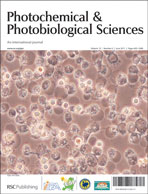A series of six Bodipy derivatives, namely 4,4-difluoro-8-(4-amidophenyl)-1,3,5,7-tetramethyl-4-bora-3a,4a-diaza-s-indacene (1), 4,4-difluoro-8-(4-methylphenyl)-1,3,5,7-tetramethyl-4-bora-3a,4a-diaza-s-indacene (2), 4,4-difluoro-8-(4-nitrylphenyl)-1,3,5,7-tetramethyl-4-bora-3a,4a-diaza-s-indacene (3), 4,4-difluoro-8-(4-amidophenyl)-3,5-dimethyl-4-bora-3a,4a-diaza-s-indacene (4), 4,4-difluoro-8-(4-methylphenyl)-3,5-dimethyl-4-bora-3a,4a-diaza-s-indacene (5), and 4,4-difluoro-8-(4-nitrylphenyl)-3,5-dimethyl-4-bora-3a,4a-diaza-s-indacene (6) were structurally characterized by single crystal X-ray diffraction analysis. Two methyl substituents attached at C-1 and C-7 positions of boron-dipyrromethene (Bodipy) moiety in compounds 1–3 were revealed to prevent the free rotation of the benzene moiety, resulting in a molecular configuration with an almost orthogonal dihedral angle between the Bodipy and benzene moieties with the dihedral angle in the range of 81.14–88.56°. This is obviously different from that for 4–6 with a free-rotating benzene moiety relative to the Bodipy core due to the lack of two methyl substituents in the latter series of compounds, leading to an enhanced interaction between the Bodipy and benzene moieties for 4–6 in comparison with 1–3. The resulting larger HOMO–LUMO gap for 1–3 than 4–6 results in a blue-shifted absorption band for 1–3 relative to that for 4–6. Comparative studies over their fluorescence properties also disclose the blue-shifted fluorescence emission band and corresponding higher fluorescence quantum yield for 1–3 relative to those of 4–6, revealing the effect of molecular configuration on the spectroscopic properties of Bodipy derivatives. Comparison of the redox behaviors of these two series of Bodipy compounds provides additional support for this point. In addition, the electron-donating/withdrawing property of the para substituent of the benzene moiety was shown to exhibit a slight influence on the electronic absorption and fluorescence emission properties of the Bodipy compounds.


 Please wait while we load your content...
Please wait while we load your content...